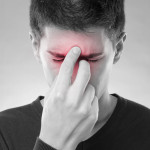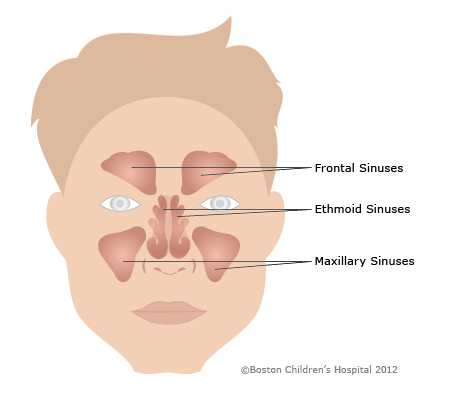Sinusitis
 Sinusitis is a medical term that means that your sinuses are inflamed (irritated and swollen), usually because of an infection. If you’ve been congested, your head feels “stuffy,” you have a bad headache, and you feel pressure or pain around your eyes (especially over your cheeks), it could be sinusitis. Read on to learn more about this condition and how it’s treated.
Sinusitis is a medical term that means that your sinuses are inflamed (irritated and swollen), usually because of an infection. If you’ve been congested, your head feels “stuffy,” you have a bad headache, and you feel pressure or pain around your eyes (especially over your cheeks), it could be sinusitis. Read on to learn more about this condition and how it’s treated.
What are your sinuses?
Your sinuses are small spaces in your skull that are filled with air. They’re located behind your eyes, cheeks, forehead, and nasal (nose) bones. They’re lined with mucus membranes that work to keep your nose from becoming dry and also trap bacteria so that it doesn’t get into your lungs.

What causes sinusitis?
Sinusitis often starts with a viral infection such as a cold, which can cause your sinuses to become inflamed, or “blocked”. When your sinuses are blocked, too much mucus builds up and doesn’t drain properly. Bacteria then get trapped in your sinuses where it’s easy for them to multiply, causing an infection.
Sinusitis can be:
- Acute (symptoms last up to 4 weeks) is the most common infection
- Sub-acute (symptoms last between 4-12 weeks)
- Chronic (symptoms last 3 months or longer)
What are the symptoms of sinusitis?
The following are all common symptoms of sinusitis:
- A cold that lasts more than 10 days and is not getting better
- A headache with a feeling of pressure
- Pain and tenderness near your eyes and cheekbones, sometimes with swelling around your eyes
- Pain in your upper teeth and jaw area
- Bad breath (even after you’ve brushed your teeth)
- A cough
- Fever
- Sore throat
- Feeling fatigued (tired)
- Yellow-green mucus from your nose
Some of these symptoms occur with other illnesses, so it’s important to see your health care provider (HCP) to make sure you get the right diagnosis and the correct treatment.
How can my health care provider tell if I have sinusitis?
Your HCP will ask you about your symptoms and examine your nose and face. This may include shining a light inside your nose to look for inflammation, and tapping on your sinuses to look for inflammation and signs of infection.
Most of the time a diagnosis is based on your symptoms and whether you’ve had a sinus infection in the past.
Rarely additional tests may be needed, including:
- A culture (laboratory test) of the fluid coming from your nose or sinuses
- CT scan (a painless procedure that produces images of your body by using x-rays and computer technology)
- Blood tests
What is the treatment for acute sinusitis?
Treatment may or may not include antibiotics (prescription medicine). Most of the time comfort measures and over the counter treatments are prescribed to relieve symptoms. Your health care provider may recommend any of the following treatments for acute sinusitis:
- Non-prescription pain medicine such as acetaminophen or ibuprofen
- Prescription or non-prescription nasal steroid sprays
- Decongestants
- Flushing the nasal passages with a saline liquid
Often (bacterial) sinusitis will get better with comfort measures alone. If symptoms do not improve within a few weeks, your HCP may decide to treat your sinus infection with an antibiotic.
Is there anything else I can do to feel better?
If you have sinusitis, make sure to follow your HCP’s advice. If your HCP has prescribed medicine, make sure to finish all of it, even if you start to feel better.
Other things that you can do to help yourself feel better include:
- Drink plenty of water and get enough rest
- Place a moist, warm washcloth on your face a few times a day
- Use a humidifier
Can I do anything to prevent sinusitis?
Yes, there are things that you can do to help prevent getting sinusitis.
Most importantly, you can:
- Wash your hands with warm water and soap to avoid picking up germs, especially if you’ve shaken hands with another person
- Don’t smoke, and avoid people who do
Other things you can do to help stay healthy include:
- Eat a healthy diet with lots of fruits and vegetables
- Drink plenty of fluid and make sure you’re not dehydrated
- Find ways to lower your stress
Source: Read Full Article



